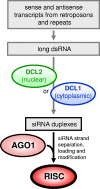RNA interference in protozoan parasites: achievements and challenges
- PMID: 21764910
- PMCID: PMC3187059
- DOI: 10.1128/EC.05114-11
RNA interference in protozoan parasites: achievements and challenges
Abstract
Protozoan parasites that profoundly affect mankind represent an exceptionally diverse group of organisms, including Plasmodium, Toxoplasma, Entamoeba, Giardia, trypanosomes, and Leishmania. Despite the overwhelming impact of these parasites, there remain many aspects to be discovered about mechanisms of pathogenesis and how these organisms survive in the host. Combined with the ever-increasing availability of sequenced genomes, RNA interference (RNAi), discovered a mere 13 years ago, has enormously facilitated the analysis of gene function, especially in organisms that are not amenable to classical genetic approaches. Here we review the current status of RNAi in studies of parasitic protozoa, with special emphasis on its use as a postgenomic tool.
Figures


References
-
- Abed M., Ankri S. 2005. Molecular characterization of Entamoeba histolytica RNase III and AGO2, two RNA interference hallmark proteins. Exp. Parasitol. 110:265–269 - PubMed
-
- Al-Anouti F., Ananvoranich S. 2002. Comparative analysis of antisense RNA, double-stranded RNA, and delta ribozyme-mediated gene regulation in Toxoplasma gondii. Antisense Nucleic Acid Drug Dev. 12:275–281 - PubMed
-
- Al-Anouti F., Quach T., Ananvoranich S. 2003. Double-stranded RNA can mediate the suppression of uracil phosphoribosyltransferase expression in Toxoplasma gondii. Biochem. Biophys. Res. Commun. 302:316–323 - PubMed
-
- Al Riyahi A., Al-Anouti F., Al-Rayes M., Ananvoranich S. 2006. Single argonaute protein from Toxoplasma gondii is involved in the double-stranded RNA induced gene silencing. Int. J. Parasitol. 36:1003–1014 - PubMed
Publication types
MeSH terms
Substances
Grants and funding
LinkOut - more resources
Full Text Sources

